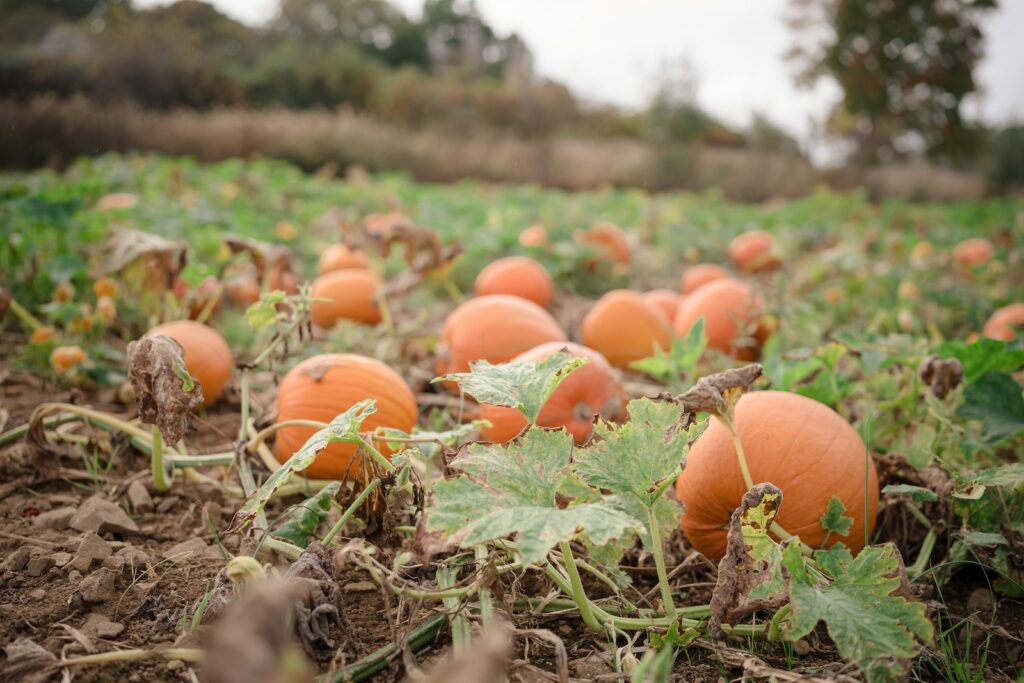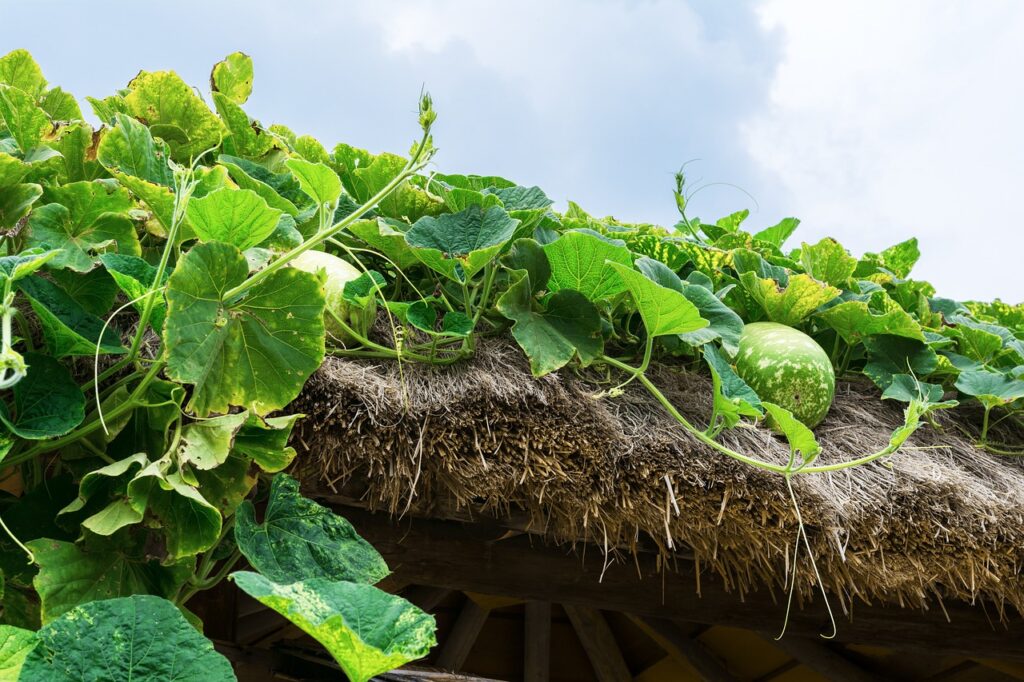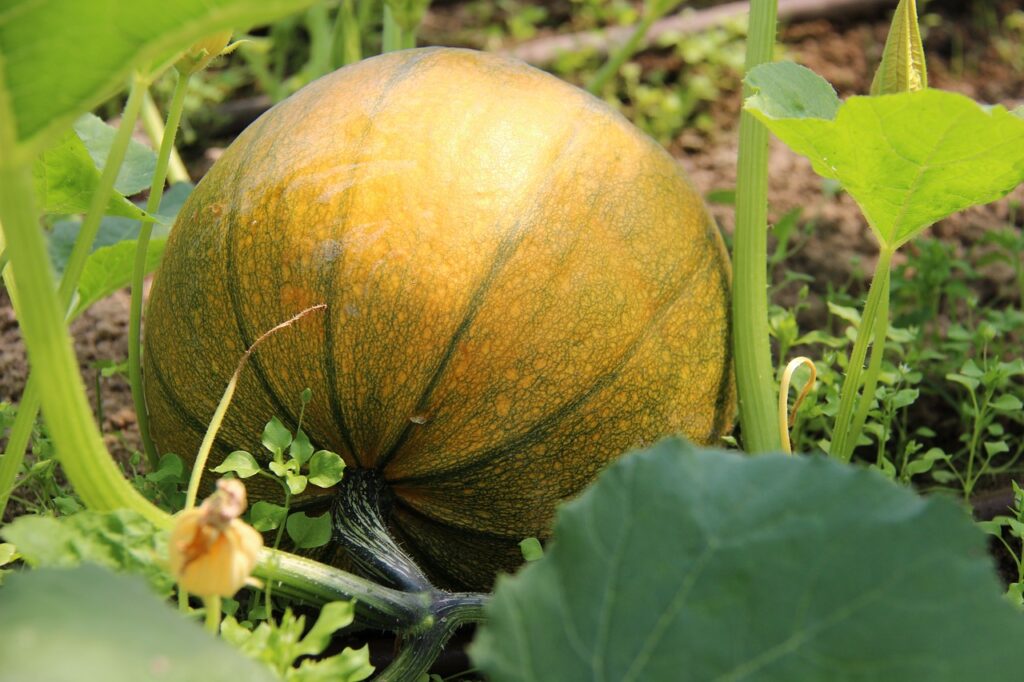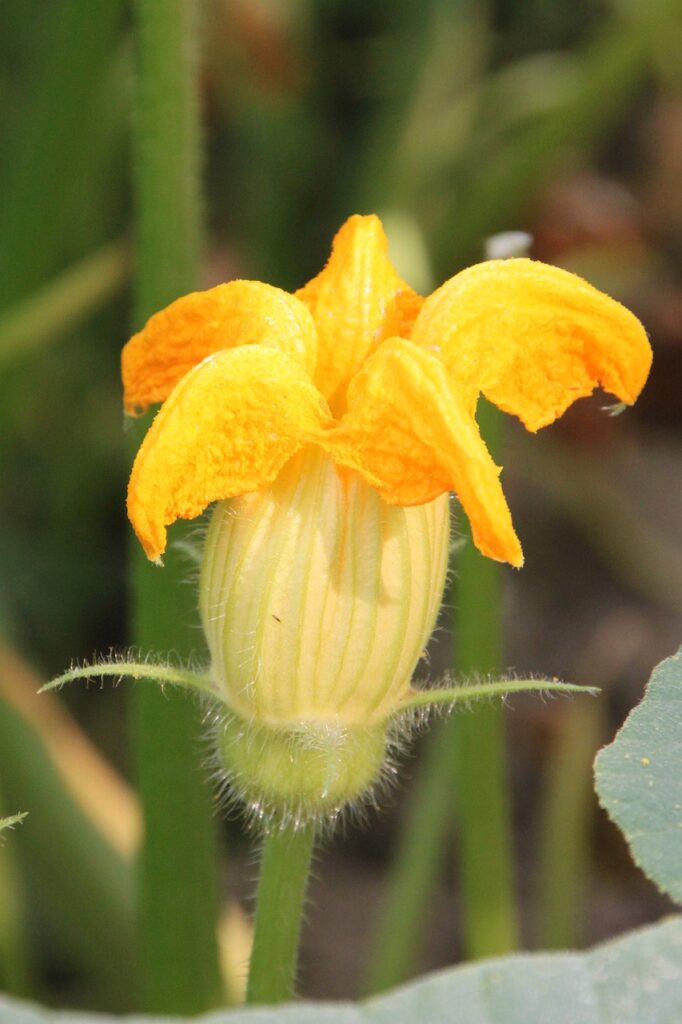
Pumpkins are a popular fall crop that are enjoyed by many during the autumn months. Whether used for decoration or in cooking, pumpkins are a staple of the season. However, not everyone is familiar with what pumpkin vines look like.
Pumpkin vines are typically large and sprawling, with long stems that can reach up to 20 feet in length. They are characterized by their large, lobed leaves that can grow up to 12 inches in diameter. The leaves are typically green in color and have a rough, slightly prickly texture.
In addition to their leaves, pumpkin vines also produce tendrils that help them climb and anchor themselves to nearby structures. These tendrils are thin and curly, and can grow up to several feet in length. Overall, pumpkin vines are a unique and recognizable plant that are easy to identify once you know what to look for.
Table of Contents
Understanding Pumpkin Vines

Pumpkin vines are the long, sprawling plants that produce the iconic orange fruit of Halloween. These vines are an essential part of the pumpkin plant’s growth cycle, providing nutrients and support for the developing fruit. Understanding the characteristics of pumpkin vines is crucial for successful pumpkin cultivation.
Shape and Size
Pumpkin vines are typically long and thin, with a cylindrical shape. The main vine can grow up to 20 feet in length, while secondary and tertiary vines can branch off from the main vine and extend up to 10 feet in length. The size and shape of the vines can vary depending on the pumpkin variety and growing conditions.
Spread and Color
Pumpkin vines have a sprawling growth habit, spreading out horizontally across the ground. The vines can cover a large area, with the main vine and secondary vines extending several feet from the base of the plant. The color of the vines is typically a bright green, with a slightly rough texture.
Texture and Green Thread
The texture of pumpkin vines is slightly rough, with small bumps and ridges running along the length of the vine. These bumps and ridges can help the vine grip onto the soil and provide support for the developing fruit. The vines also have small green threads that extend from the main stem, which can help the vine climb and attach to nearby structures.
In summary, pumpkin vines are long, thin, and cylindrical in shape, with a bright green color and slightly rough texture. They have a sprawling growth habit, spreading out horizontally across the ground, and can extend up to 20 feet in length. Understanding the characteristics of pumpkin vines is essential for successful pumpkin cultivation.
Growth and Care of Pumpkin Vines

Pumpkin plants are known for their sprawling vines that can grow up to 20 feet long. These vines are an essential part of the plant’s growth and development, as they produce the pumpkin fruit. Proper care and maintenance of pumpkin vines are crucial for a healthy harvest.
Planting and Soil Requirements
Pumpkin plants require well-draining soil that is rich in organic matter. They prefer a slightly acidic soil pH between 6.0 and 6.8. Planting should be done in full sun, and the soil should be kept moist but not waterlogged.
Watering and Fertilization
Pumpkin plants require regular watering, especially during hot and dry weather. It is recommended to water deeply once a week rather than shallowly every day. Fertilization is also essential for healthy growth. A balanced fertilizer with equal parts nitrogen, phosphorus, and potassium should be applied every two weeks.
Support and Direction
Pumpkin vines are heavy and require support to prevent them from breaking under the weight of the fruit. A trellis or support system can be used to keep the vines off the ground. It is also essential to direct the growth of the vines. Encouraging the vines to grow in a specific direction can help maximize space and sunlight.
Runners and Pruning
Pumpkin plants produce long runners that can take up a lot of space. Pruning the runners can help control the growth of the plant and prevent it from spreading too far. It is recommended to prune the runners when they reach 10 to 12 feet in length.
In summary, proper care and maintenance of pumpkin vines are crucial for a healthy and bountiful harvest. Providing adequate water, soil, and fertilization, supporting and directing the growth of the vines, and pruning runners are all essential steps in caring for pumpkin plants.
Pumpkin Fruit and Flowers

Pumpkins are a type of fruit that grow on vines. They are typically round or oblong in shape and have a hard, thick outer shell. The flesh of a pumpkin is often used in cooking, while the seeds can be roasted and eaten as a snack.
Pumpkin plants also produce flowers, which are important for pollination. These flowers can be either male or female. Male flowers have long, thin stems and are typically found in clusters. Female flowers, on the other hand, have a small, bulbous base that will eventually become the pumpkin.
To produce fruit, pumpkin plants need to be pollinated. This is typically done by bees, who transfer pollen from the male flowers to the female flowers. Without pollination, pumpkins will not grow.
It is important to note that not all flowers on a pumpkin plant will produce fruit. Some flowers may be infertile or may not receive enough pollen to produce a pumpkin. Additionally, pumpkins may produce multiple fruit on a single vine.
In summary, pumpkin plants produce both fruit and flowers. The fruit is typically round or oblong in shape and has a hard, thick outer shell. The flowers are important for pollination and can be either male or female. Bees are typically responsible for pollinating pumpkin plants, and not all flowers will produce fruit.
Varieties of Pumpkin Vines

Pumpkin vines come in a variety of shapes, sizes, and colors. Some of the most common varieties of pumpkin vines include the Atlantic Giant, miniature pumpkins, and pumpkins in shades of orange, yellow, white, and red.
The Atlantic Giant is a popular variety of pumpkin vine that is known for producing large pumpkins. These pumpkins can weigh up to 200 pounds and are often used in competitions. The vines of the Atlantic Giant are thick and sturdy, with large leaves that provide ample shade for the developing pumpkins.
Miniature pumpkins are another popular variety of pumpkin vine. These vines produce small pumpkins that are perfect for decorating or for use in cooking. The vines of miniature pumpkins are thin and delicate, with small leaves that allow the pumpkins to receive plenty of sunlight.
Pumpkins come in a variety of colors, including orange, yellow, white, and red. Orange pumpkins are the most common and are often used for carving and decorating. Yellow pumpkins are less common but can add a unique touch to fall decorations. White pumpkins are becoming increasingly popular and are often used for elegant fall displays. Red pumpkins are less common but can add a bold pop of color to any fall arrangement.
In summary, pumpkin vines come in a variety of shapes, sizes, and colors. The Atlantic Giant, miniature pumpkins, and pumpkins in shades of orange, yellow, white, and red are just a few of the many varieties of pumpkin vines available.
Harvesting and Usage

Once the pumpkin vines have produced mature pumpkins, it’s time to harvest them. The ideal time to harvest pumpkins is when they have reached their full size and have a uniformly deep orange color. The skin should be firm and hard to the touch, and the stem should be dry and brown. If the stem is green, it means the pumpkin is not yet ripe and should be left on the vine for a few more days.
To harvest the pumpkin, use a sharp knife or pruning shears to cut the stem about 2-3 inches above the pumpkin. Be careful not to damage the stem or the pumpkin itself. Once harvested, pumpkins can be used in a variety of ways.
Pumpkin seeds can be saved for planting next year or roasted for a healthy snack. To roast pumpkin seeds, rinse them in water and remove any pulp. Spread them out on a baking sheet and sprinkle with salt. Roast in a preheated oven at 350°F for about 20-30 minutes, stirring occasionally, until golden brown.
Pumpkins are often used in cooking and baking, especially in the fall and winter months. They can be used to make soups, pies, bread, and other baked goods. Fresh pumpkin can be boiled or roasted and pureed for use in recipes. Canned pumpkin puree is also widely available and can be used as a substitute for fresh pumpkin in many recipes.
Pumpkins are also popular for carving into jack-o’-lanterns for Halloween. To carve a pumpkin, cut off the top and scoop out the seeds and pulp. Then, use a sharp knife to cut out a face or design. Place a candle or light inside the pumpkin to illuminate the design.
Overall, pumpkins are a versatile and nutritious crop that can be enjoyed in a variety of ways. Whether harvested from a pumpkin patch or purchased from a local market, pumpkins are a staple of autumn and a favorite ingredient for many recipes.
Dealing with Pests and Diseases
When growing pumpkin vines, it is important to be aware of the potential pests and diseases that can damage or kill the plants. Here are some common issues and ways to deal with them:
Insects
The most common pests that affect pumpkin vines are vine borers, squash bugs, and cucumber beetles. Vine borers are a type of moth larvae that tunnel into the stems of the plant, causing wilting and eventual death. To prevent this, you can wrap the base of the plant with aluminum foil or use row covers to protect the vines.
Squash bugs and cucumber beetles can also cause damage to the leaves and fruits of the plant. To control these pests, you can use insecticidal soap or neem oil, or try companion planting with marigolds or nasturtiums.
Diseases
One of the most common diseases that affect pumpkin vines is powdery mildew. This fungal disease appears as a white or gray powdery coating on the leaves and can cause them to turn yellow and die. To prevent powdery mildew, make sure to provide good air circulation around the plants and avoid watering the leaves.
Other diseases that can affect pumpkin vines include bacterial wilt and downy mildew. These can cause wilting and yellowing of the leaves, and can be spread by insects or contaminated soil. To prevent these diseases, make sure to rotate your crops and practice good sanitation by removing any infected plants or debris from the garden.
Overall, by being aware of the potential pests and diseases that can affect pumpkin vines, and taking steps to prevent and control them, you can enjoy a healthy and productive harvest.
Planting and Germination
Planting pumpkin seeds is relatively easy and straightforward, but it is essential to follow a few key steps to ensure optimal germination and growth. The following paragraphs will outline the necessary steps for planting and germinating pumpkin seeds successfully.
Firstly, it is essential to choose the right location for planting pumpkins. The ideal location is a sunny area with well-draining soil. Pumpkins require a lot of energy and nutrition to grow, so it is crucial to ensure that the soil is rich in nutrients. It is recommended to fertilize the soil before planting the seeds to provide the necessary nutrients.
Once the location is selected, it is time to plant the seeds. The best time to plant pumpkin seeds is in the late spring or early summer when the soil has warmed up. The seeds should be planted about an inch deep, and the soil should be kept moist but not waterlogged. It is recommended to plant several seeds in each location to ensure that at least one seed sprouts.
After a few days, the pumpkin seeds should begin to sprout. Once the sprouts appear, it is essential to thin out the seedlings and leave only the healthiest ones. The seedlings should be spaced about two feet apart to allow for adequate plant growth.
As the pumpkin seedlings grow, it is essential to provide support for the vines. Pumpkin vines can grow up to 20 feet long, so it is crucial to provide a sturdy string or trellis for the vines to grow on. This will also help to keep the pumpkins off the ground and prevent rotting.
In conclusion, planting and germinating pumpkin seeds is relatively easy and straightforward, but it is essential to follow a few key steps to ensure optimal growth. By choosing the right location, planting the seeds correctly, thinning out the seedlings, and providing support for the vines, you can grow healthy and robust pumpkins.
Controlling Pumpkin Vines
Controlling pumpkin vines is an important aspect of pumpkin cultivation. As pumpkin vines grow, they can quickly take over a garden, smothering other plants and competing for nutrients. Here are some tips for controlling pumpkin vines:
Pruning
One effective way to control pumpkin vines is through pruning. Pruning involves removing the tips of the vines and any lateral shoots that emerge. This helps to redirect the plant’s energy towards fruit production rather than vine growth.
It is important to note that pruning should only be done when the plant has reached a certain size. Pruning too early can stunt growth and reduce yields.
Wire Support
Another way to control pumpkin vines is through the use of wire support. This involves running a wire trellis or fence along the length of the garden bed and training the vines to grow up and along the wire. This helps to keep the vines contained and prevents them from spreading out and taking over the garden.
Controlling Vines
In addition to pruning and wire support, there are other methods for controlling pumpkin vines. These include:
- Regularly removing any suckers or lateral shoots that emerge from the base of the plant.
- Using physical barriers such as plastic or fabric to prevent vines from spreading.
- Applying mulch around the base of the plant to suppress weed growth and prevent vines from rooting in new areas.
Overall, controlling pumpkin vines is an important part of pumpkin cultivation. By using a combination of pruning, wire support, and other methods, gardeners can keep their vines under control and ensure a healthy and productive harvest.
Pumpkin Vines and Their Cultural Significance
Pumpkin vines are an integral part of the pumpkin plant, which is a member of the Cucurbita family. They are native to North America and have been cultivated for thousands of years. Today, pumpkins are grown all over the world, and their vines are an essential component of the plant’s growth and development.
Giant pumpkins, which can grow to be hundreds of pounds, are the most well-known type of pumpkin. They require a lot of space and nutrients to grow, which is why their vines can extend up to 25 feet long. However, not all pumpkin vines are this long. Some varieties, such as the Sugar Pie pumpkin, have shorter vines that are only a few feet long.
Pumpkin vines come in a variety of colors, including green, yellow, and even red. They can also vary in size, with some vines growing to be a few inches in diameter, while others can be several inches thick. The type of pumpkin vine depends on the variety of pumpkin being grown.
Aside from the aesthetic appeal of pumpkin vines, they also have cultural significance. Pumpkins have been used for centuries in North America for their medicinal properties, and their vines are no exception. They are believed to have a variety of benefits, including aiding in digestion and reducing inflammation.
Overall, pumpkin vines are an essential component of the pumpkin plant and play a significant role in its growth and development. They come in a variety of shapes, sizes, and colors and have cultural significance due to their medicinal properties. Whether you’re growing giant pumpkins or smaller varieties, pumpkin vines are a key factor in producing a healthy and fruitful crop.